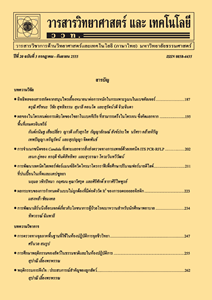วัสดุกันความร้อนฝ้าเพดานจากวัสดุเชิงประกอบนาโนระหว่างดินขาวตามธรรมชาติและคาร์บอน
Main Article Content
Abstract
บทคัดย่อ
งานวิจัยนี้มีวัตถุประสงค์เพื่อศึกษาถึงความเป็นไปได้ในการพัฒนาวัสดุเชิงประกอบนาโนระหว่างดินขาวตามธรรมชาติและคาร์บอน (natural kaolin/carbon nanocomposite) เพื่อเป็นฉนวนกันความร้อนภายในอาคารสำหรับงานฝ้าเพดาน โดยใช้ดินขาวจากแหล่งธรรมชาติและคาร์บอนจากดอกธูปฤาษีที่สังเคราะห์มาจากวิธี ไฮโดรเทอร์มอล โดยการเพิ่มสัดส่วนของคาร์บอนเป็นปริมาณตั้งแต่ร้อยละ 1-10 โดยน้ำหนัก ส่วนผสมละ 2 ตัวอย่าง วัสดุเชิงประกอบนาโนระหว่างดินขาวและคาร์บอนสามารถสังเคราะห์ได้ง่ายด้วยวิธีการหล่อเจล ขึ้นรูปด้วยขนาด 10 x 10 x 0.5 ซม.3 จากนั้นทดสอบหาค่าความหนาแน่น การกันความร้อน การไม่ลามไฟ รวมทั้งทดสอบการรับแรงกดแตกและการดูดซึมน้ำ ผลการวิจัยพบว่าวัสดุตามสัดส่วนนี้ โดยภาพรวมมีสมบัติไม่ลามไฟ สามารถรับแรงกดแตกเฉลี่ยได้ในช่วง 202-350 นิวตัน มีความหนาแน่นเฉลี่ยตั้งแต่ 1.327-1.449 กรัม/ซม.3 (ตามสัดส่วนคาร์บอนที่ลดลง) สามารถกันความร้อนได้ดี โดยส่วนผสมที่มีคาร์บอนเป็นสัดส่วนร้อยละ 8-10 โดยน้ำหนัก จะสามารถกันความร้อนได้ดีที่สุดถึงร้อยละ 30 เมื่อเทียบกับตัวอย่างที่เป็นดินขาวบริสุทธิ์ แต่ไม่เข้าข่ายเป็นผลิตภัณฑ์ประเภททนความชื้น ดังนั้นผลการวิจัยนี้ชี้ให้เห็นว่ามีความเป็นไปได้ในการพัฒนาวัสดุเชิงประกอบนาโนระหว่างดินขาวและคาร์บอน ให้เป็นฉนวนกันความร้อนสำหรับงานภายในอาคาร
คำสำคัญ : ดินขาว; คาร์บอน; วัสดุเชิงประกอบนาโน; ฉนวนกันความร้อนฝ้าเพดาน
Abstract
This research aimed to study the feasibility of developing the natural kaolin/carbon nanocomposites for ceiling insulation. Kaolin was obtained from natural resource and carbon was obtained from Typha angustifolia flower via hydrothermal method. A mixture of two composite samples was prepared by increasing the proportion of the carbon content ranging from 1-10 percent by weight. Kaolin/Carbon nanocomposites were successfully synthesized using gel casting method and molded the size of 10 x 10 x 0.5 cm3. The engineering properties which were tested included density, insulation, fire retardant, breaking load and water absorption. The results showed that the new material was a fire retardant material, the breaking loads were averaged with the range of 202-350 newton and the densities were averaged among 1.327-1.449 g/cm3 (with the decreasing of carbon ratio). It was found that the efficiency of this nanocomposite material was very high for insulation. In addition, the samples with the carbon ratio of 8-10 percent by weight were the most effective used for insulation by more than 30 percent comparing to the non-carbon material. However, it could not be used as a moisture resistance material. As a result, it could be said that a new nanocomposite material was introduced for ceiling insulation.
Keywords: kaolin; carbon; nanocomposite material; ceiling insulation


